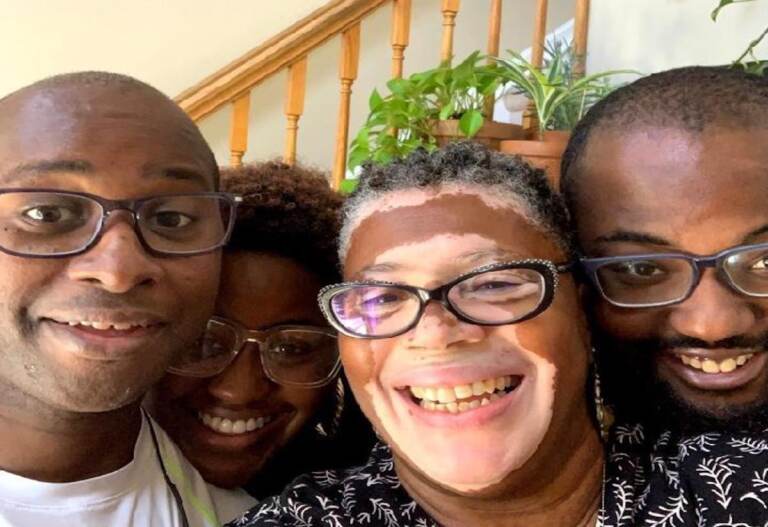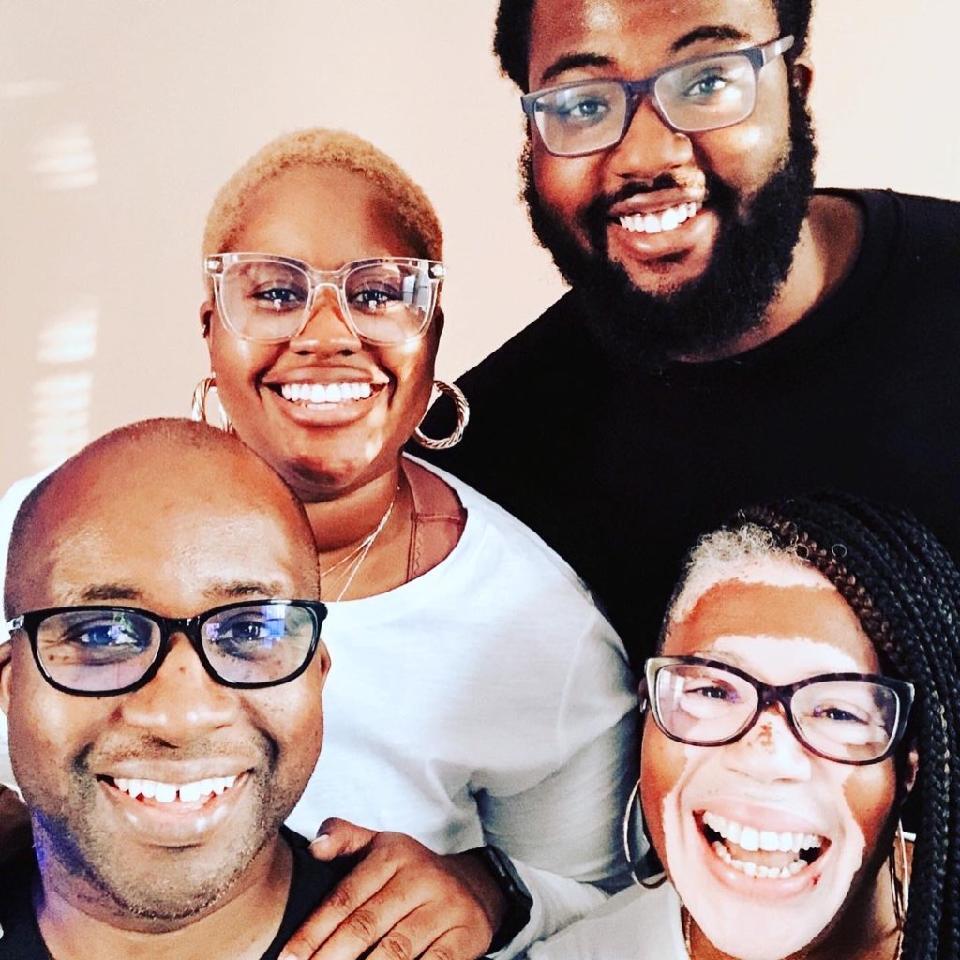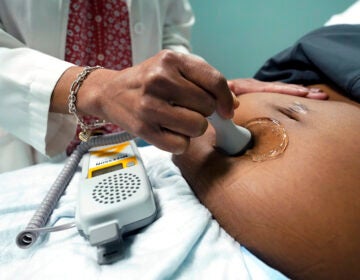The real pain behind vitiligo and its unequal effect on people of color
With only one FDA approved topical cream for vitiligo — finding comfort in one’s own skin comes at a cost.
Listen 8:13
From left to right: Alphonso, Rachel, Rita and Joshua Scarborough (Courtesy of Rita Scarborough).
This story is from The Pulse, a weekly health and science podcast.
Find it on Apple Podcasts, Spotify, or wherever you get your podcasts.
At 9 years old, Rita Scarborough had experienced more trauma than most children. Her older brother was killed in a hit-and-run bus accident in Philadelphia, her parents were going through a divorce, and she started noticing some unusual spots of lighter skin appearing on her body.
“I started seeing these white spots on my feet,” she said. “And my mom checked it out and she was like, ‘This is really strange.’ She didn’t know what it was. She had never seen it before.”
Scarborough’s mother was African American and her father was Mexican. She inherited a dark-bronze complexion, and to see one part of her skin turning ‘white’ was perplexing.
“When we first went to the doctor, we just went to a regular medical doctor,” she said. “He was like, ‘I’m not sure what this is.’”
She was referred to a dermatologist who determined the official diagnosis to be vitiligo — a disease known to cause patches of skin to lose pigmentation — usually ivory white or pale pink. This was during the 1970s and Scarborough’s dermatologist told her he hadn’t seen many cases of vitiligo.
“And so, they made the suggestion to do the cosmetic creams, ‘you can cover it up and you can do that — and that may make you feel more comfortable.’”
But the gut-punch really came when Scarborough heard something that she wasn’t expecting to find out.
“There’s no cure. It’s not going to do anything to take it away. That part they were clear on,” she said.
Vitiligo affects roughly 1% of the world’s population. Although that’s a low percentage, it’s frequently misdiagnosed or not reported at all. Symptoms usually include patches of discolored skin on the hands, feet, and face — but it can affect all skin surfaces and show up as premature white patches of hair and scalp.
Researchers and doctors have spent years trying to pinpoint what causes vitiligo which is still unknown. Some research has suggested that stressful life events such as divorce, job loss, or trauma can trigger symptoms, especially with individuals already immunocompromised.
There is no cure for vitiligo. It’s also a disease that affects people of all skin tones, regardless of race and ethnicity. There are some options to address the disease, like topical creams and phototherapies to either cover up or repigment skin. But with most treatments comes a cost.
Subscribe to The Pulse
Rita Scarborough’s vitiligo eventually migrated to her face, around her eyes and mouth as she became older.
For her family, the price of treatment was too expensive without enough insurance coverage — which they didn’t have.
So, she went years without treatment.
“It was hard for my mom because people would always stare. And she would get angry,” she said.
And as her symptoms got worse, so did the emotional pain. Amongst her childhood friends, Scarborough was bullied for her dark and ‘light’ appearance.
“Everybody knew who I was. Everybody there was like, ‘Oh, the girl who’s black and white, she lives right there,’” Scarborough said. “Whenever I stepped into any space or place, instantly people could see I was different. Nobody wanted to touch me, nobody wanted to play with me. It was very, very hard for me as a young person. I isolated myself as a protection.”
Vitiligo isn’t associated with symptoms of physical pain. Its worst symptom might be the stigmas that come with it. It’s a stigma that doesn’t affect everyone with the disease the same way.
“I have vitiligo on half my face — I have a white eyebrow,” said Lionel Bercovitch, professor of dermatology at Warren Alpert Medical School at Brown University. “That’s the only really visible part of it. It has zero impact on my life. Nobody recoils when they see my face.”
Bercovitch is also the director of pediatric dermatology at Hasbro Children’s Hospital in Providence, Rhode Island.
“But someone who has dark skin, who is very white — they’re ivory white; they’re not just lighter skin patches — on dark skin, they’re very conspicuous.”
He said that’s the cruelty of vitiligo. It discriminates against people of color far out of proportion compared to patients with lighter skin. It’s “just by nature of the disease,” he said.
He says this highlights the importance of making treatments more affordable. But as recently as 2021, Bercovitch said that some insurance companies in Rhode Island denied coverage for vitiligo treatment altogether.
The reasons: Creams specially for repigmenting skin were not FDA approved, and moreover, treatment was considered “cosmetic” and not medically necessary.
“Every time we would request prior authorization for treatment, we couldn’t get it,” he said.
The price of vitiligo skin creams varies, but some estimates for a single tube range between $300 and $2,500 – or more.
In 2022, the FDA approved the first cream for vitiligo, Opzelura, from the Delaware-based pharmaceutical company, Incyte. And while FDA approval is a huge step, that doesn’t necessarily translate to equal access across the board, Bercovitch said.
“It’s so expensive,” he said. “Even though it’s FDA approved for vitiligo — it’s unlikely that patients are going to easily get coverage for it.
Access to treatment is an issue that won’t go away, said Amit Pandya, president of the Global Vitiligo Foundation and a practicing dermatologist in Sunnyvale, California.
“The health care disparities in vitiligo is perhaps more important even than health care disparities for other conditions because of the appearance of the skin being recognizable by the public,” he said.
Pandya said that while an FDA approved treatment is on the market for vitiligo, it doesn’t eliminate all challenges.
“When you go to a grocery store and you see an African-American person with vitiligo, you can tell from across the store that that person has vitiligo,” he said. “But if you’re a Caucasian, especially if you don’t have much of a tan, you can walk right past people in the grocery store and people don’t know they have vitiligo. And my patients who are Caucasian have told me that.”
Living with vitiligo can foment feelings of fear, anger, and loneliness. For people of color, it can be more isolating when dermatologists of color are hard to find.
“Dermatology is actually the second least diverse specialty of all kinds of specialties in medicine,” said Temitayo Ogunleye, professor of dermatology at the University of Pennsylvania, “It’s only second behind orthopedic surgery. So only about 3% of dermatologists are Black, 4% are Latino. Less than 1% are American Indian or Native American.”
Ogunleye believes that having a dermatologist that shares similar experiences of stigmas and racism makes a big difference in practice. She said that some providers can only understand the emotional burden that people of color, particularly women, experience with vitiligo.
“When we diminish the impact of skin tone and skin, even us and culture and value, we’re doing a disservice to Black people,” she said. “We deserve equal care. I think at the end of the day, that’s the bottom line.”
For Rita Scarborough, talking about her experiences with family, friends, and others suffering from vitiligo, has had a positive influence on her life.

Now a mother of two, she hasn’t used topical creams or phototherapy since her initial diagnosis as a child. And she’s comfortable with that.
“Everybody’s not going to handle it the same way,” she said. “For me, it helped to not put myself in that situation where it’s going to be more of an issue — where I’m thinking about this constantly. Initially a person with vitiligo is going to think, ‘Is this going to help me get better or not? And how much is that going to cost me? Do I have to do this for the rest of my life?’”
Rita still gets asked frequently if she’s Black or white. At this point in her life, it’s a question that she laughs at more often than not. Her response, however, is the same.
“I’m a Black woman and I’m proud to be a Black woman. I’m a Black woman with vitiligo.”
Support for WHYY’s coverage of health equity issues comes from the Commonwealth Fund.
WHYY is your source for fact-based, in-depth journalism and information. As a nonprofit organization, we rely on financial support from readers like you. Please give today.







